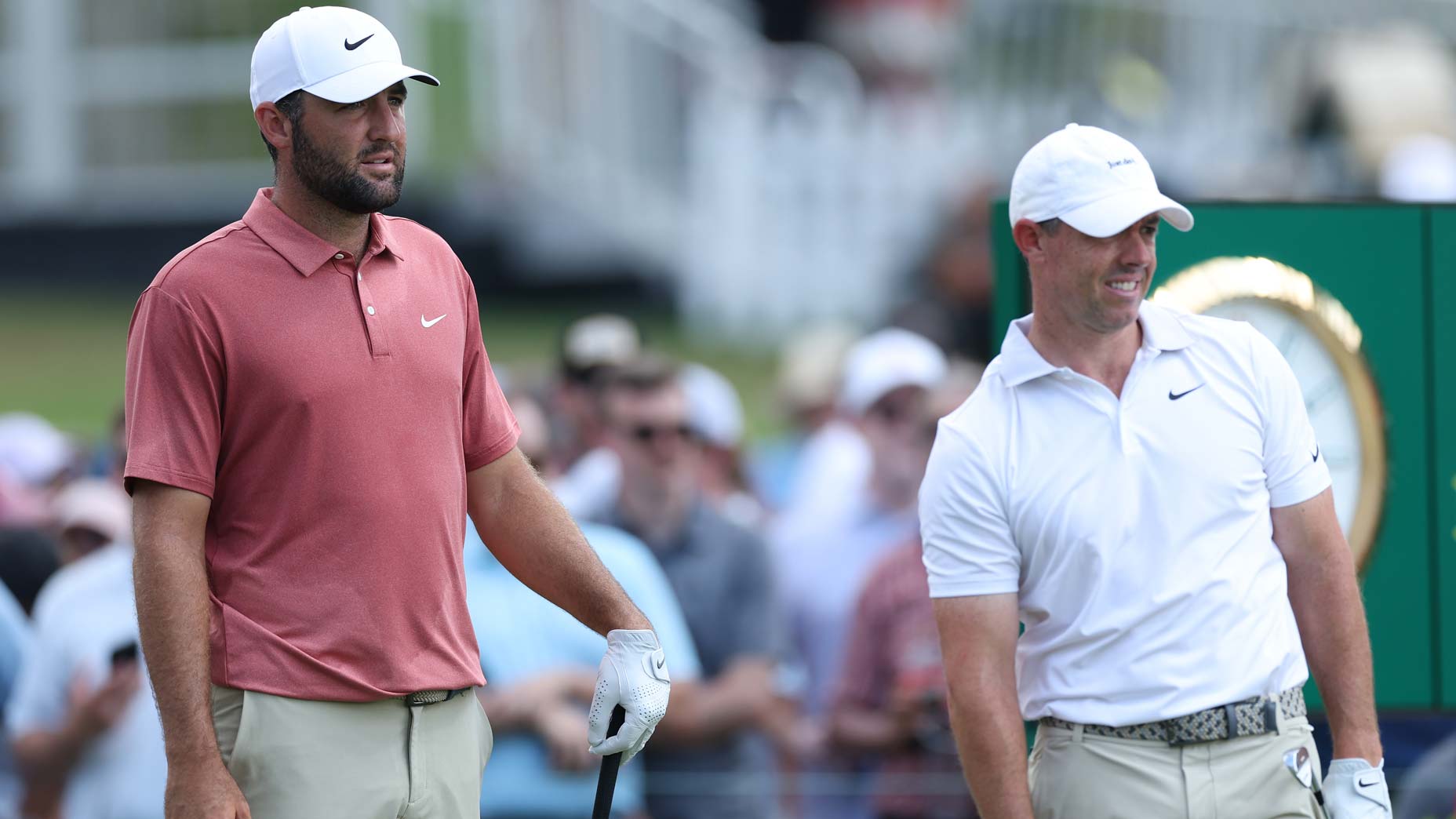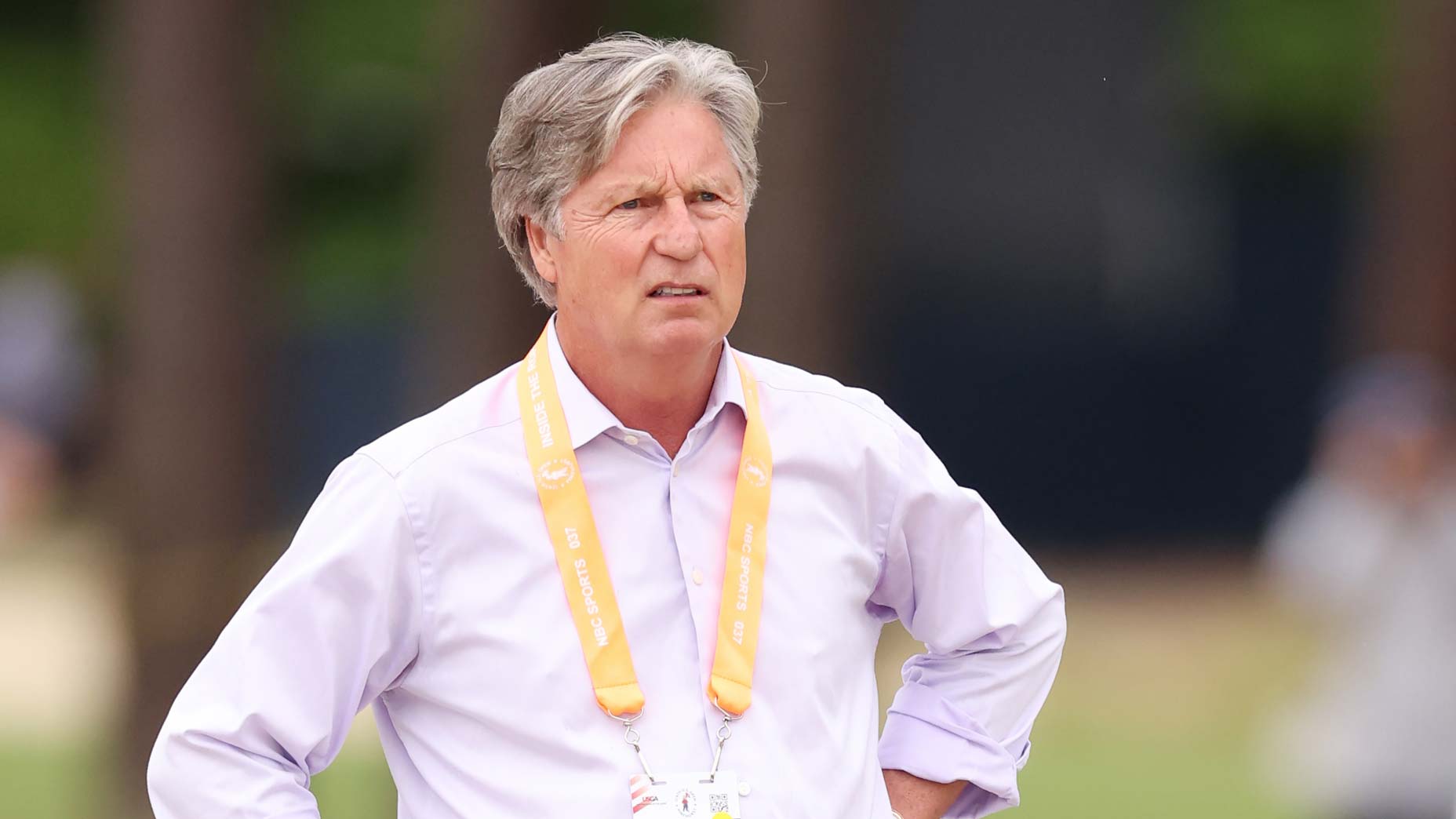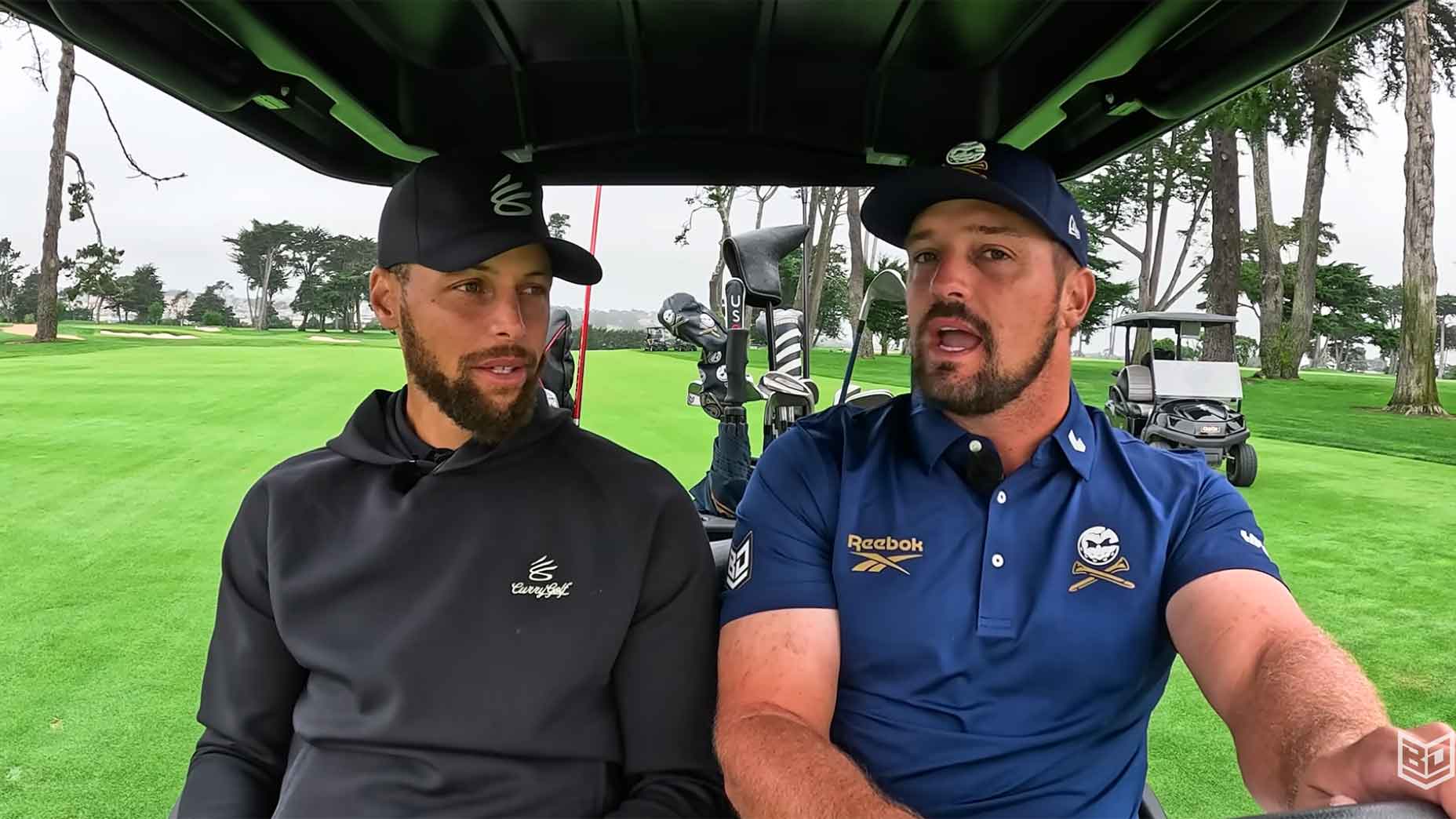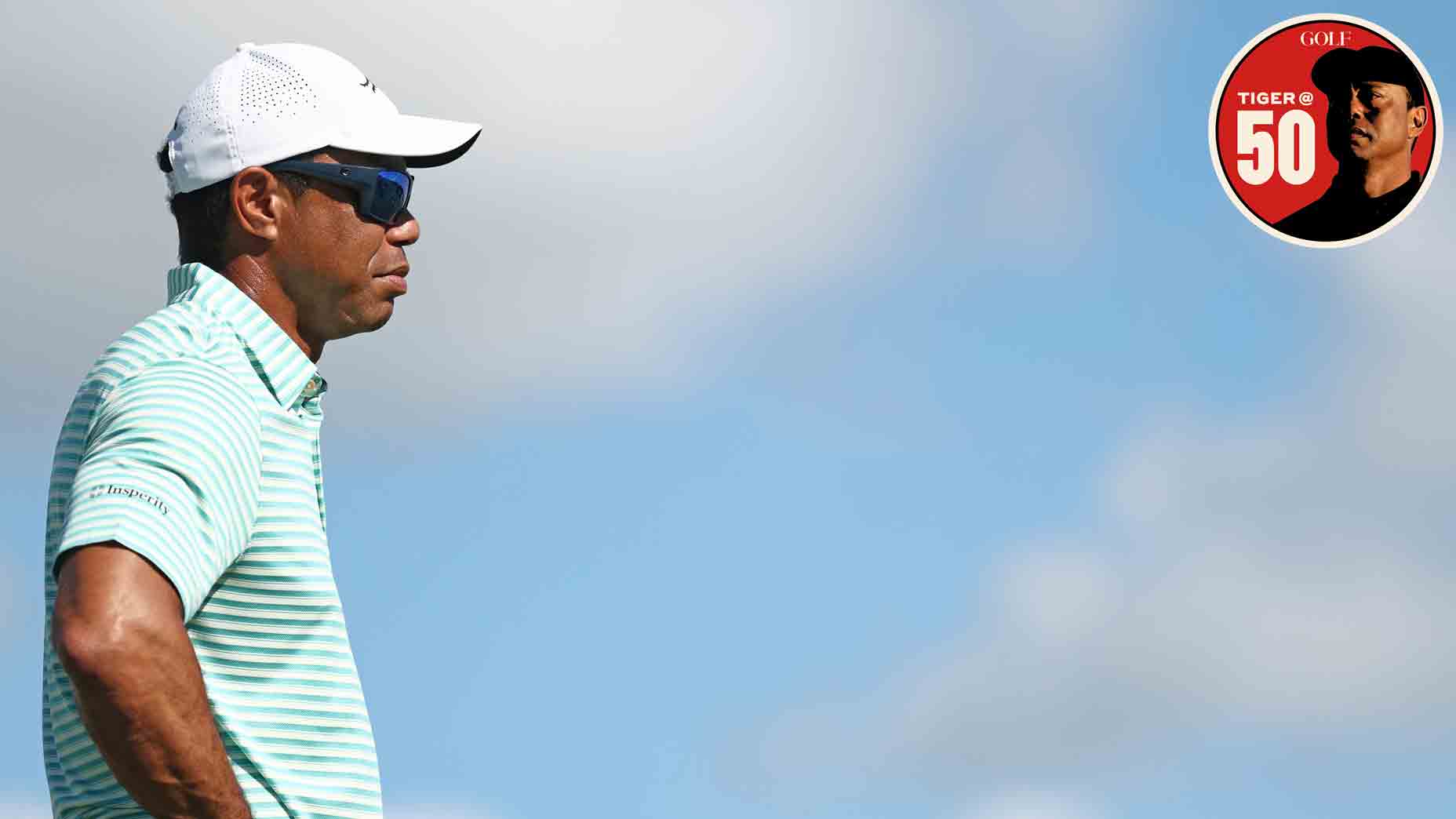Dinner time at Pat Perez’s house. The red wine is flowing, the stuffed pork chops are sizzling and the host is enjoying a tasty bit of revenge, a dish that is best served cold. In November the 40-year-old Perez won for only the second time in his PGA Tour career, in just his third start back after left-shoulder surgery had put his future in golf in peril. To hear Perez tell it, the victory was the feel-bad story of the year.
“I was so excited to come back, and then I got a call from Callaway [last July],” he says of the equipment company that had sponsored him for the preceding three years. “They said they had nothing for me in 2017. I said, ‘O.K., fine. You don’t believe in me, you don’t believe in my comeback, then f— you.’ I loved those irons, but I couldn’t wait to put something else in the bag and then shove it up Callaway’s ass. It was such a motivator. I thought about it all day and all night, month after month. All I could think was, I am going to bury these people and nothing is going to stop me. So you ask me how it felt to win? That’s how it felt to win.”
Callaway, in fact, did come back while Perez was still on the mend and offer him a contract early last fall, and company spokesman Harry Arnett says, “We loved having Pat on our staff and continue to root for him to play well on Tour.” But never mind all that; Perez’s bitter recounting jibes with the widespread perception that he is golf’s angriest man. The reputation dates to his days at Arizona State, where he achieved the rare feat of leading his team to a national championship and then getting kicked off it a year later because, he says, “the coach was bringing in all these hot-s— recruits, and I guess he thought I would be a bad influence on them.” (That coach, Randy Lein, concurs, saying, “Pat would have been our only senior, and he was too immature to be in a leadership position.”) The bad boy image metastasized at Pebble Beach during his rookie year in 2002 when, after slicing a shot out-of-bounds on the 14th hole, Perez excavated vast swaths of the fairway as part of a nationally televised fit of pique. He still came to the 18th hole with a one-stroke lead but kicked away the tournament by pushing his drive out-of-bounds and then hooking his fourth shot into Stillwater Cove en route to a fatal triple bogey. “I’ll never forget talking to Pat a little while after Pebble,” says Tour veteran Jason Gore, who played junior golf with Perez. “He says, and you’ll have to excuse my language, ‘The f—— commissioner wants me to go to anger-management classes. If they make me go do that I’m gonna be so f—— pissed.’ That’s Pat.”
Perez has never tried to fit in on Tour, favoring skull belt buckles and a neomullet inspired by the 1980s hair metal bands he pals around with. He was once fined for flipping off a disobedient golf ball on live TV, and even at the most stately of country clubs he always works blue. “For Pat the f-word is like a comma,” explains Gore. “I fully understand that from the outside he comes off as an obnoxious schmuck you want to punch in the neck. But deep down he has a good soul. He just doesn’t want anyone to know it.”
Indeed, on a Tour that is as cliquish as high school, Perez is embraced by the pagans and the Christians. For mentors he chose Tommy Armour III, John Daly and Steve Elkington, iconoclasts all, but he plays practice rounds with Aaron Baddeley, a devout Christian, and at tournaments he often rooms with the shy, polite Jason Kokrak. Perez will fill up the rental house with groceries and cook every night for Kokrak, who says, “He has such a big heart. He loves to take care of people. About the only thing Pat won’t do is bake me cookies and tuck me into bed at night.”
Perez is fiercely loyal to his friends. He played high school golf in San Diego with Mike Hartford, who hired Perez for his landscaping business at $5 an hour. Perez has, in turn, employed Hartford (also known as H) as his caddie and says the job is his for life, a brotherhood built on contrasts. “I drink, he doesn’t,” says Perez. “I smoke, he doesn’t. I spend money, he doesn’t. I cuss, he doesn’t. I’m a motherf—–, he isn’t.”
[gallery:13805142]Perez’s best friend from Arizona State is Darren Angel, a mini-tour player who, like Hartford, has moved within 10 minutes of his pal’s home in Scottsdale, and the three spend most of their free time parked in Perez’s living room, watching sports on a trio of TVs. They bet on everything, though since money never changes hands, the primary currency is trash talk. Says Angel, “Pat’ll call me first thing in the morning and say, ‘I got North Dakota State.’ I won’t even know what sport he’s talking about.”
At home Perez dotes on two poofy little dogs and is often whispering sweet nothings to his wife, Ashley. He is courtly and warm with her mother, Susan, whom he calls Mom. Perez is prone to random acts of kindness, such as in 2015 when he left at Hooters dozens of free passes to the Phoenix Open for fellow fans of the website The Chive, for which he now has a modest endorsement deal. He is a tireless advocate for charities that support military families; he and his father, Tony, a Vietnam vet, run an annual tournament for combat-injured troops called Operation Game On. Pat may have cultivated a rebellious rock ’n’ roll image, but how tough can you really be when your ringtone is Betty Who’s romantic ballad “All of You”? He loves ’80s pop, and Perez dancing in his kitchen, crooning to Madonna, is the picture of contentment. “I’m the happiest I’ve ever been,” he says. “Life is great. Considering the dark hole I was in less than a year ago, thinking my career might be over, you can’t make this stuff up.”
Though the dearth of victories leads Perez to label himself “a pretty big underachiever,” he has kept his Tour card for 15 straight seasons, which speaks to his consistency and tenacity. The ability to keep his job year after year without the exemptions that come with wins is, according to Gore, “one of the more underrated achievements in pro golf.” Perez hasn’t exactly mellowed—the Callaway rant is proof of that—but the time away from the game to repair a torn left labrum had a profound effect on his outlook. “Best thing that’s ever happened to me,” he says. “It showed me how much I mean to the game of golf, which is nothing. Maybe four [Tour players] reached out to me the whole time I was hurt. If they don’t give a f— about me, why am I trying to please them? Why do I care what they think? Being hurt gave me so much time to think about who I want to be and how I want to play the game. I decided when I came back I was just going to be me and do things my way. I came back so refreshed it almost felt like being a rookie again.”
Which means this reborn Perez may yet turn into the player he was always supposed to be.
***
In the 1980s and early ’90s, Phil Mickelson and Tiger Woods were the gods of Southern California junior golf, but there were times that Perez outshined both. In 1993, when he was 17, he won his hometown Junior Worlds, dusting Woods by eight shots. That summer Perez also took the Maxfli Junior Championship by shooting a 63 at Pinehurst No. 4. He set various records at Torrey Pines High, which has sent six players to the PGA Tour. Pat learned the game from his father, and he and his younger brother, Mike, picked the Torrey Pines range and filled in divots in exchange for free access to the course and practice facilities. His family was working-class in a swank part of the world, so while the La Jolla brats Perez competed against had the best of everything, he swung his father’s cut-down clubs and sported clothes with the wrong logos. Being of Hispanic heritage in a blindingly white game didn’t help. “I got racial stuff thrown at me all the time,” says Perez. “I still do. It’s fine; I give it right back. The way I came up made me tougher, because absolutely nothing was given to me.”
At Arizona State he was always one of the best players on the team, but Perez chafed at the structure Lein imposed and wasn’t shy about expressing his dissatisfaction. Their complicated relationship was only part of what made the team so dysfunctional. “I remember one tournament we all played together as a fivesome,” says Perez. “We won by 10 shots but almost didn’t finish the final round because we were all about to brawl. We were rooting against each other even as we were trying to win the tournament, if that makes sense. We just wore each other out, which unfortunately made me into the prick I am.”
As a sophomore Perez played in only six tournaments during the regular season, but he was a stalwart in the postseason, leading the Sun Devils to the Pac-10 and NCAA titles. The next year was more of a struggle, for Perez and the team, and after getting booted off the squad he left school, even though he had a year of eligibility remaining. He returned to San Diego and for a year made minimum wage delivering merchandise for the golf equipment company McHenry Metals. “I wasn’t even thinking about playing professionally,” he says. “I had no money. My family had no money. How the hell was I supposed to even try?” Then in the summer of 1997, a San Diego businessman offered to sponsor him in a couple of mini-tour events. Perez won the first one he entered, on the Golden State tour. He was told he could remain an amateur or take the $2,000 first prize and turn pro on the spot. “Easiest decision of my life,” he says. He won his next four mini-tour starts and worked his way up to the Canadian tour and then the Nationwide tour. In the fall of 2001 he finally reached the big show, playing his way through the grueling PGA Tour’s Q school.

From the beginning Perez has done things his way. Unlike every other player on Tour, he leaves club selection to his caddie. “I put my entire trust in H,” he says. “He’ll say, ‘You’ve got 158 [yards] front, 172 hole, 165 over this corner, wind off the left, give me a three-quarter six-iron.’ Bang. Done. He can see it more clearly than I can. With all the pressure and the nerves, it’s easy to lose your head out there.”
Which brings us to the 14th fairway at Pebble Beach, the fourth event of Perez’s rookie year. After knocking the shot out-of-bounds, he proceeded to gouge the fairway in disgust, wildly swinging his club as if it were an axe. It might have been golf’s most memorable blowup since (Terrible) Tommy Bolt hurled his driver into a lake at the 1960 U.S. Open. “It affected me for a long time,” says Perez, who still finished second and pocketed $432,000. “I had to act different. I had to prove to people that I wasn’t this f—— hothead, even though I am. It got to the point where I didn’t care [on the course], because I had to make sure everybody saw me not getting mad. If I cared too much I’d get mad.”
It didn’t help his golf that his first mentor on Tour was Daly, and that Perez adopted his hard-living ways. After a bender in Las Vegas, he was so close to missing his tee time that at a stoplight he popped his trunk, jumped out of the car and grabbed his spikes so he could put them on, saving the precious seconds that allowed him to make his tee time. At the 2005 Byron Nelson Classic he was bunking at Armour’s house in Dallas, and after the third round the two stayed out partying until 5:30 a.m. Perez came home and passed out on the couch but was awakened a short time later by Armour’s brother with the disconcerting news that his tee time was less than an hour away. “H sees me on the range and says, ‘Have you been drinking? I say, ‘How can you tell?’ He says, ‘I can smell it from 20 feet away.’ When I went to tee up my ball on the 1st hole I almost fell flat on my face.” With this taste for the high life he became pals with a bevy of rock stars, professional athletes, actors and various other bold-faced names. It took 198 tries, but Perez finally won, at the 2009 Bob Hope, with a kick-in eagle on the 72nd hole. About two dozen friends and family members engulfed him in a melee on the final green, including Gore, Armour, baseball player Pat Burrell, and hockey players Brian Savage and Branden Gracel. Says Perez, “Arnie [Palmer] was there, and he was looking around like what the hell is going on? I promise you, he’d never seen a celebration that crazy before.”
Perez was unable to build on that victory because of flaws in his game and his approach. He had been purely a feel player and believed that identifying himself as such meant he didn’t really have to understand his swing. He got by on a remarkable short game and could be deadly with his short irons, but the longer the clubs the more his flaws were magnified. Seeking quick fixes, Perez went through a series of swing instructors, each one imparting his own ideas. “When I see my swing from years ago I don’t know how the hell I kept my job,” he says. “I must’ve had one of the worst long games in the history of the Tour.”
The first building block for his late-career renaissance came about five years ago in Las Vegas, where he dined with a large group at STK Vegas. He was seated next to Ashley, a friend of a friend, but, “We had been already been drinking for a while, and I was so housed I didn’t even notice her,” he says. Perez tucked into a skirt steak and immediately demanded that the waitress bring the chef to the table. He nervously approached, and Perez shouted, “This steak is so good I want to give you a h— j– right here. I mean it. Drop your pants.”
“That was the moment when I started liking him,” says Ashley. “I appreciated the weirdness.” They’ve been together since, Perez having proposed three years ago by calling Ashley on stage at a New Year’s Eve party at the MGM Grand in Las Vegas. At their wedding a year later they served the entree that brought them together, and it was given its proper name on the printed menus: h— j– skirt steak.
Ashley, 29, is a fierce advocate for her man. “I remember when we had just started dating, I was walking with Pat’s agent and I said, ‘How come Pat is the only guy out here without endorsements?’ And he said, ‘Oh, because he’s unsellable.’ And I was like, Well, guess what? You’re not his agent anymore. He thought I was kidding, but I was dead serious, and just like that he was gone. Pat needed people who believed in him.” In the last couple of years he has signed endorsement deals with MGM Resorts International and William Murray Golf clothing, which explains why the brand’s patriarch, Bill Murray, can sometimes be spotted in Perez’s gallery.
Ashley also gets the credit/blame for her hubby’s hairdo. “I think it’s sexy,” she coos. “Look at that picture,” she adds, pointing to an image on the dining room hutch of a short-haired, boyish-looking Perez. “That’s boring as s—. This guy with the long hair looks like he’s ready to party.” Says Gore, “I think he wears it long just to irritate people. I hate it too, but every time I see him I say, ‘Hey, Pat, your hair looks great. Keep growing it out, man.’ Hearing that is the only way to get him to cut it.”
In fact, last week Perez trimmed six inches off his locks, because he grew tired of his hair blowing in his face while playing in Hawaii. “I’m sure all those bald f—— on Tour will be happy about it,” he says. “But unlike them, my hair grows back.”
***
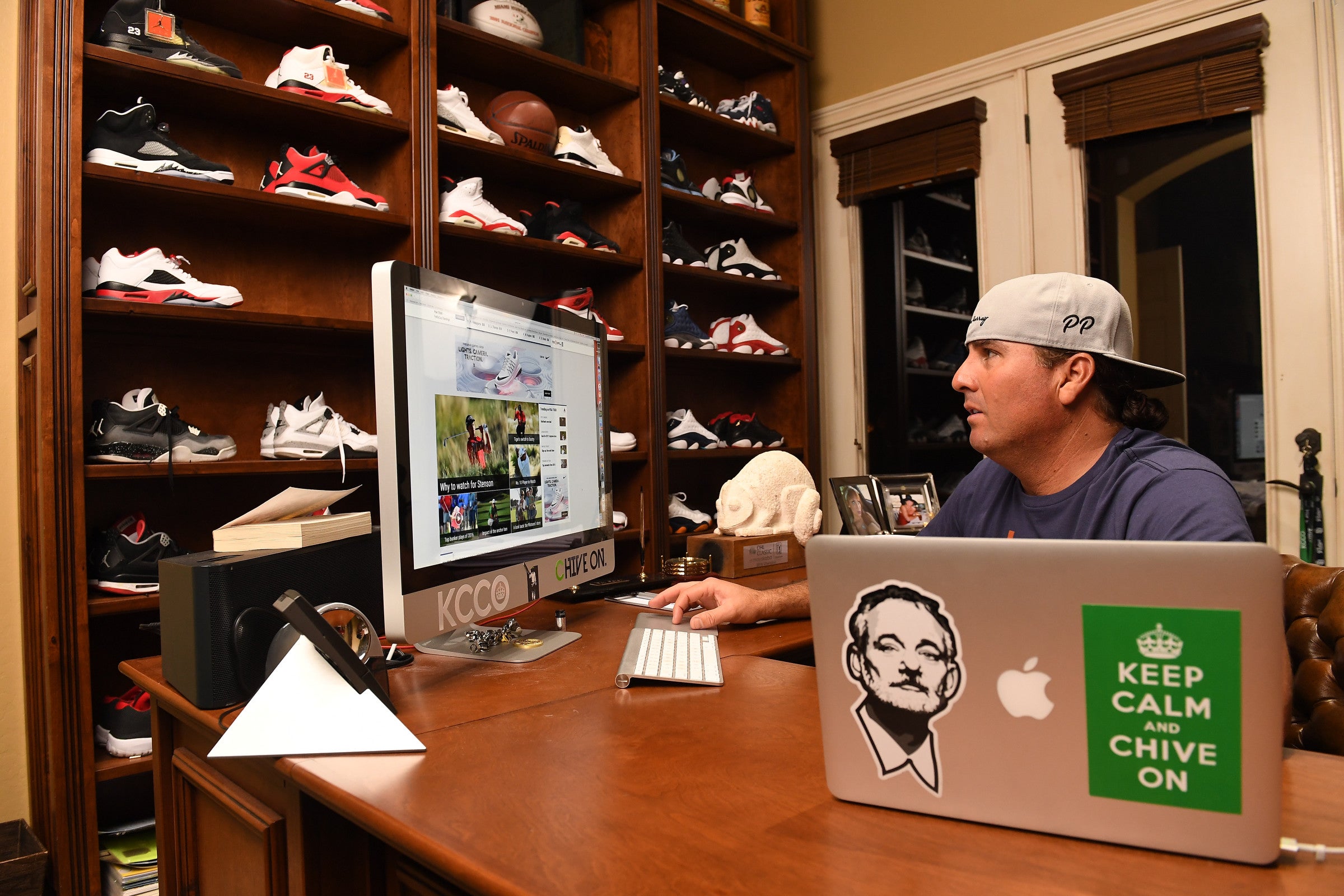
While Perez was recovering from his surgery he spent a lot of time ruminating about his golf game, and early on in his seven-month recuperation he rang his swing coach of the past two years, Drew Steckel, with an idea: He wanted Adam Scott’s action. “Well, that wasn’t going to happen,” says Steckel. “You gotta love who you are; you can’t be the skinny girl who thinks she’s fat. Pat has never really known what he’s doing; he’s always just tinkered and tried new things. All I’ve done is give him a blueprint and a routine, and as he was coming back from the injury he became tenacious about following it.”
After extensive testing, Perez found a driver and ball combination that gave him a game-changing 30 more yards off the tee. Still, the key to Perez’s victory last fall at the OHL Classic at Mayakoba (with TaylorMade woods, PXG irons and a Titleist ball) was metaphysical. For all of his brashness, Perez never really believed in himself when it came to crunch time: “I’d always been afraid when I’d been near the lead. Well, not afraid, but I didn’t have the right attitude or the right trust. I spent a lot of time thinking about how I can do things differently. I decided if I have a chance to win, I’m going to go for the throat and I’m going to keep attacking the way all the top players do in every sport. When you play that aggressively, there’s no room to be scared.”
On the morning of the final round at Mayakoba, his last words to Ashley before leaving for the course were, “Babe, wear something nice because I’m going to win today.” After Perez birdied the 1st hole, he turned to Hartford and said, “It’s over.” He went out in 31 to build a four-shot lead and didn’t stop firing at flags until he had run out of holes. In the wake of the two-stroke victory there was a massive outpouring of support on The Chive, an unfamiliar feeling for a guy who has always been an outsider. “My whole career I’ve played in front of basically nobody and now every time I tee it up I have all these crazy Chivers screaming my name and blowing up my Twitter,” says Perez. “I’m not gonna lie: it feels good to have people cheering for me.”
Among the many perks that came with the victory were invitations to the Masters and the Tournament of Champions in Maui, where Perez continued his strong play with a third-place tie. “I’ve never loved the game this much,” he said while seated in the caddie yard at the T of C; he often hangs out with the loopers rather than in the posh player digs. “I feel like I have 10 more good years in me, and I’m gonna keep busting my ass to make the most of them. I want to win more tournaments. I want to make Presidents Cup and Ryder Cup teams. I want to set this game on fire.”
Of course, he will still have plenty of fun along the way. Over the holidays Pat and Ashley partied in Maui with Steven Tyler, Fergie, Jim Carrey and Owen Wilson at the house of Perez’s pal Shep Gordon, the music producer. And as usual, Perez was the rare Tour pro who played music during his practice rounds. One day at the Tournament of Champions he was bumping old-school West Coast gangsta rap, a befitting soundtrack for golf’s O.G. The pious Baddeley pretended not to notice the endless profanity booming out of the portable speaker on Perez’s cart. On the 5th hole the two caught up to Mackenzie Hughes, a rookie who was earnestly charting every inch of the course. Perez doesn’t converse so much as his inner monologues bubble forth, and as he approached the green, he couldn’t contain himself: “I’m gonna call him Mac, I don’t care if he doesn’t like it. Everyone gets a nickname this year. There’s no stopping me. I’m back, baby. I’m back. Love me or hate me, I’m back. Deal with it, motherf——.”

